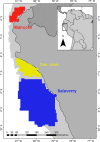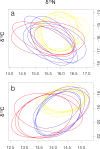Stable isotope and fatty acid analyses reveal significant differences in trophic niches of smooth hammerhead Sphyrna zygaena (Carcharhiniformes) among three nursery areas in northern Humboldt Current System
- PMID: 33981504
- PMCID: PMC8071072
- DOI: 10.7717/peerj.11283
Stable isotope and fatty acid analyses reveal significant differences in trophic niches of smooth hammerhead Sphyrna zygaena (Carcharhiniformes) among three nursery areas in northern Humboldt Current System
Abstract
Fishery pressure on nursery areas of smooth hammerhead in northern Peruvian coast have become a serious threat to sustainability of this resource. Even though, some management actions focused on conservation of the smooth hammerhead populations were proposed in recent years, their scientific foundations are often limited, and biomass of smooth hammerhead in Peruvian waters continues to decrease. To inform management and conservation, this study aims to evaluate the trophic niche of smooth hammerhead juveniles from three nursery areas in the northern Peruvian coast using stable isotope and fatty acid analyses. First, we compared the environmental characteristics of each nursery area (i.e., sea surface temperature and chlorophyll-a concentration) and concluded that nursery areas differed significantly and consistently in sea surface temperature. Subsequently, we evaluated isotopic composition of carbon and nitrogen and fatty acid profiles of muscle and liver tissues collected from juvenile smooth hammerhead from each nursery area. We found that juvenile smooth hammerhead captured in San José were enriched in heavier 13C and 15N isotopes compared to those captured in Máncora and Salaverry. Furthermore, the broadest isotopic niches were observed in juveniles from Máncora, whereas isotopic niches of juveniles from Salaverry and San José were narrower. This difference is primarily driven by the Humboldt Current System and associated upwelling of cold and nutrient rich water that drives increased primary production in San José and, to a less extent, in Salaverry. Compared to smooth hammerhead juveniles from Máncora, those from San José and Salaverry were characterised by higher essential fatty acid concentrations related to pelagic and migratory prey. We conclude that smooth hammerhead juveniles from three nursery areas in the northern Peruvian coast differ significantly in their trophic niches. Thus, management and conservation efforts should consider each nursery area as a unique juvenile stock associated with a unique ecosystem and recognize the dependence of smooth hammerhead recruitment in San José and Salaverry on the productivity driven by the Humboldt Current System.
Keywords: Denitrification; Feeding dynamics; Humboldt Current System; Isotopic niche; Sharks nursery areas.
©2021 Segura-Cobeña et al.
Conflict of interest statement
The authors declare there are no competing interests. Eduardo Segura-Cobeña and Jeffrey Mangel are employees of ProDelphinus. Joanna Alfaro-Shigeto is a director of ProDelphinus.
Figures





Similar articles
-
Nursery Resource Use Dynamics in Great Hammerheads (Sphyrna mokarran) Across Ontogeny.Ecol Evol. 2025 Jun 16;15(6):e71473. doi: 10.1002/ece3.71473. eCollection 2025 Jun. Ecol Evol. 2025. PMID: 40524778 Free PMC article.
-
Diet, trophic interactions and possible ecological role of commercial sharks and batoids in northern Peruvian waters.J Fish Biol. 2021 Mar;98(3):768-783. doi: 10.1111/jfb.14624. Epub 2020 Dec 15. J Fish Biol. 2021. PMID: 33222156
-
Population and individual foraging patterns of two hammerhead sharks using carbon and nitrogen stable isotopes.Rapid Commun Mass Spectrom. 2015 May 15;29(9):821-9. doi: 10.1002/rcm.7169. Rapid Commun Mass Spectrom. 2015. PMID: 26377010
-
Studying animal niches using bulk stable isotope ratios: an updated synthesis.Oecologia. 2020 May;193(1):27-51. doi: 10.1007/s00442-020-04654-4. Epub 2020 May 11. Oecologia. 2020. PMID: 32393994 Review.
-
The northern shrimp (Pandalus borealis) offshore fishery in the Northeast Atlantic.Adv Mar Biol. 2007;52:147-266. doi: 10.1016/S0065-2881(06)52002-4. Adv Mar Biol. 2007. PMID: 17298891 Review.
Cited by
-
Fatty acid profiles of highly migratory resources from the Southeastern Pacific Ocean, Chile: a potential tool for biochemical and nutritional traceability.PeerJ. 2025 Mar 20;13:e19101. doi: 10.7717/peerj.19101. eCollection 2025. PeerJ. 2025. PMID: 40124606 Free PMC article.
-
The Influence of Habitat Heterogeneity and Human Disturbance on Trophic Interactions of Sebastiscus marmoratus and Scorpaenopsis cirrosa in Wanshan Archipelago.Ecol Evol. 2025 Jul 24;15(7):e71869. doi: 10.1002/ece3.71869. eCollection 2025 Jul. Ecol Evol. 2025. PMID: 40718689 Free PMC article.
-
Fatty acid biomarkers reveal the interaction between two highly migratory species in the Southern Humboldt System: the swordfish and its prey, the jumbo squid.PeerJ. 2025 Mar 18;13:e19129. doi: 10.7717/peerj.19129. eCollection 2025. PeerJ. 2025. PMID: 40124620 Free PMC article.
References
-
- Anderson MJ. A new method for non-parametric multivariate analysis of variance. Austral Ecology. 2001;26:32–46. doi: 10.1080/13645700903062353. - DOI
-
- Anderson MJ. Permutational multivariate analysis of variance (PERMANOVA) In: Balakrishnan N, Colton T, Everitt B, Piegorsch W, Ruggeri F, Teugels JL, editors. Wiley StatsRef: Statistics Reference Online. 2017.
-
- Argüelles J, Lorrain A, Cherel Y, Graco M, Tafur R, Alegre A, Espinoza P, Taipe A, Ayón P, Bertrand A. Tracking habitat and resource use for the jumbo squid Dosidicus gigas: a stable isotope analysis in the Northern Humboldt Current System. Marine Biology. 2012;159:2105–2116. doi: 10.1007/s00227-012-1998-2. - DOI
-
- Bec A, Perga ME, Koussoroplis A, Bardoux G, Desvilettes C, Bourdier G, Mariotti A. Assessing the reliability of fatty acid-specific stable isotope analysis for trophic studies. Methods in Ecology and Evolution. 2011;2:651–659. doi: 10.1111/j.2041-210X.2011.00111.x. - DOI
-
- Beck MW, Heck KL, Able KW, Childers DL, Eggleston DB, Gillanders BM, Halpern B, Hays CG, Hoshino K, Minello TJ, Orth RJ, Sheridan PF, Weinstein MP. The identification, conservation, and management of estuarine and marine nurseries for fish and invertebrates. Bioscience. 2001;51:633–641. doi: 10.1641/0006-3568(2001)051[0633:TICAMO]2.0.CO;2. - DOI
LinkOut - more resources
Full Text Sources

